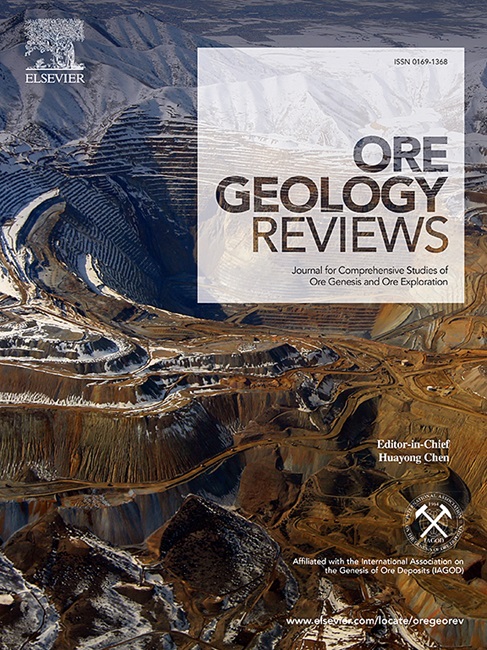Stratigraphy, facies, and chemostratigraphy at the Palaeoproterozoic Rävliden North Zn-Pb-Ag-Cu VMS deposit, Skellefte district, Sweden
IF 3.2
2区 地球科学
Q1 GEOLOGY
引用次数: 0
Abstract
Many base and precious metals are sourced from volcanic massive sulphide (VMS) deposits and understanding the geological characteristics of such deposits is crucial for new discoveries of this deposit type. Although key geological characteristics of modern VMS systems are relatively well understood, a remaining challenge is resolving the same geological characteristics in ancient, complex, altered and metamorphosed VMS deposits. One such deposit is the Palaeoproterozoic Rävliden North deposit, an 8.7 Mt (combined resources and reserves of 3.42 % Zn, 0.90 % Cu, 0.54 % Pb, 81 g/t Ag, and 0.24 g/t Au) replacement-style volcanic massive sulphide deposit in the felsic-bimodal western Skellefte district, northern Sweden. The VMS deposits in the Skellefte district are hosted in rocks subjected to greenschist to amphibolite facies metamorphism and occur at the lithostratigraphic contact between the metavolcanic 1.89 – 1.88 Ga Skellefte group (SG) and stratigraphically overlying metasiliciclastic 1.89 – 1.87 Ga Vargfors group (VG). Intense hydrothermal alteration commonly eradicates original rock textures, and polyphase deformation and metamorphism make geological interpretation and stratigraphic reconstruction difficult. Hence, to complement lithofacies analysis, immobile element chemostratigraphy is used in this study.
Rävliden North is predominantly hosted by felsic volcanic rocks of the herein defined Rävliden formation in the upper part of the SG that were deposited in half grabens related to rifting of a continental arc. Based on immobile elements and their ratios the felsic rocks fall into three groups, Rhy I, II and III. The chemostratigraphy and lithostratigraphy roughly coincide, where Rhy II (Zr/Al2O3 = 12.86, Al2O3/TiO2 = 36.07, Zr/TiO2 = 0.05) defines the rhyolites beneath the Rävliden formation that predominantly comprises Rhy I (Zr/Al2O3 = 17.23, Al2O3/TiO2 = 32.33, Zr/TiO2 = 0.06) and Rhy III (Zr/Al2O3 = 17.95, Al2O3/TiO2 = 36.53, Zr/TiO2 = 0.07), where Rhy I is the chief host to mineralisation. Mineralisation is partially hosted by graphitic phyllite that overlies the Rävliden formation and represents the base of the VG that indicates paused volcanism important for the build-up of massive sulphides beneath the seafloor. Facies analysis of rhyolites suggest that these were unconsolidated pumice rich rocks permeable for the upwelling hydrothermal fluids. Additionally, graphitic phyllite functioned as a permeability barrier inducing lateral fluid flow resulting in more effective sulphide precipitation.
This study demonstrates the effectiveness of combining stratigraphic, facies and chemostratigraphic analysis for targeting VMS deposits in complex, altered and metamorphosed rocks.

求助全文
约1分钟内获得全文
求助全文
来源期刊

Ore Geology Reviews
地学-地质学
CiteScore
6.50
自引率
27.30%
发文量
546
审稿时长
22.9 weeks
期刊介绍:
Ore Geology Reviews aims to familiarize all earth scientists with recent advances in a number of interconnected disciplines related to the study of, and search for, ore deposits. The reviews range from brief to longer contributions, but the journal preferentially publishes manuscripts that fill the niche between the commonly shorter journal articles and the comprehensive book coverages, and thus has a special appeal to many authors and readers.
 求助内容:
求助内容: 应助结果提醒方式:
应助结果提醒方式:


